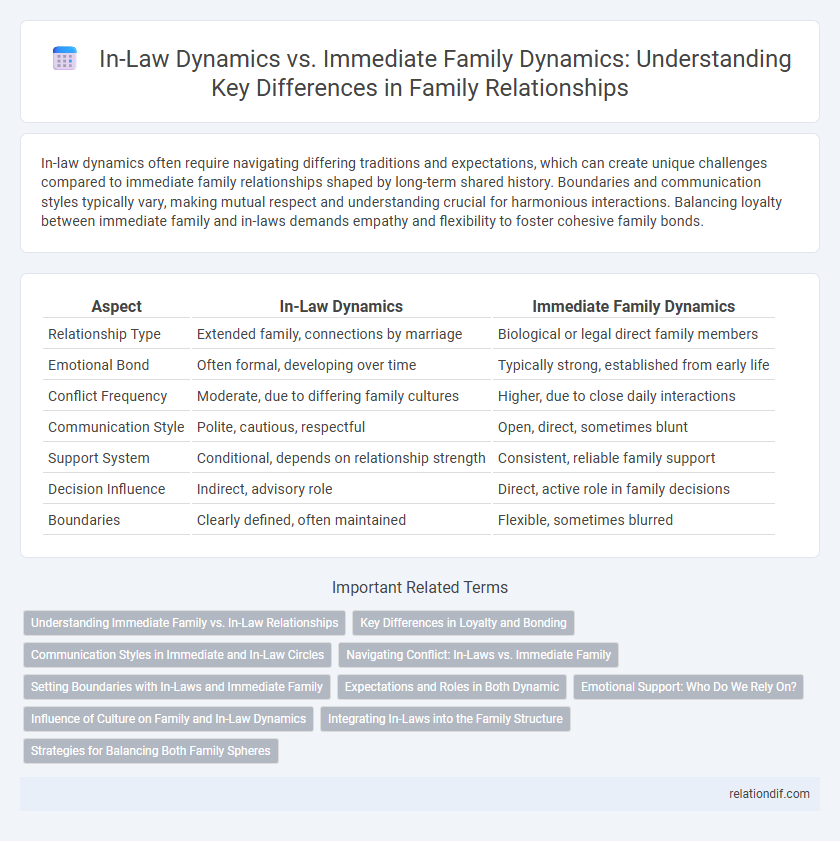In-law dynamics often require navigating differing traditions and expectations, which can create unique challenges compared to immediate family relationships shaped by long-term shared history. Boundaries and communication styles typically vary, making mutual respect and understanding crucial for harmonious interactions. Balancing loyalty between immediate family and in-laws demands empathy and flexibility to foster cohesive family bonds.
Table of Comparison
| Aspect | In-Law Dynamics | Immediate Family Dynamics |
|---|---|---|
| Relationship Type | Extended family, connections by marriage | Biological or legal direct family members |
| Emotional Bond | Often formal, developing over time | Typically strong, established from early life |
| Conflict Frequency | Moderate, due to differing family cultures | Higher, due to close daily interactions |
| Communication Style | Polite, cautious, respectful | Open, direct, sometimes blunt |
| Support System | Conditional, depends on relationship strength | Consistent, reliable family support |
| Decision Influence | Indirect, advisory role | Direct, active role in family decisions |
| Boundaries | Clearly defined, often maintained | Flexible, sometimes blurred |
Understanding Immediate Family vs. In-Law Relationships
Immediate family relationships are characterized by deeply rooted emotional bonds, shared history, and daily interactions that foster trust and mutual support. In-law dynamics often involve navigating new boundaries, cultural differences, and varying expectations, requiring intentional communication and patience to build rapport. Understanding these distinctions enhances family cohesion and promotes harmonious connections across both family spheres.
Key Differences in Loyalty and Bonding
In-law dynamics often involve navigating newly formed relationships influenced by external family ties, whereas immediate family dynamics are rooted in lifelong shared experiences and deeper emotional history. Loyalty in immediate families tends to be unconditional and instinctive, while in-laws may require deliberate trust-building and reciprocity to strengthen bonds. The bonding process with in-laws often hinges on mutual respect and establishing common ground, contrasting with the inherent familiarity that characterizes immediate family connections.
Communication Styles in Immediate and In-Law Circles
Communication styles in immediate families often rely on long-established patterns of openness and familiarity, enabling direct and emotionally expressive exchanges. In contrast, in-law dynamics typically involve more cautious and formal communication, shaped by respect for boundaries and the need to navigate new relational roles. Understanding these differing styles is crucial for fostering harmony and reducing misunderstandings in blended family environments.
Navigating Conflict: In-Laws vs. Immediate Family
Navigating conflict between in-laws and immediate family requires understanding the unique emotional ties each group holds, as immediate family often shares long-standing history while in-laws bring new perspectives and expectations. Effective communication and setting clear boundaries help balance loyalty and respect, reducing misinterpretations that commonly trigger disputes. Prioritizing empathy and collaborative problem-solving fosters harmony and strengthens family bonds amid differing dynamics.
Setting Boundaries with In-Laws and Immediate Family
Setting boundaries with in-laws requires clear communication and respect to maintain harmony while honoring cultural differences and family traditions. Immediate family dynamics often involve more frequent interactions, making consistent boundary reinforcement essential to prevent misunderstandings and emotional strain. Balancing these boundaries supports healthy relationships by ensuring personal space and mutual respect across both family circles.
Expectations and Roles in Both Dynamic
In-law dynamics often involve managing expectations shaped by cultural traditions and external family norms, contrasting with the more flexible roles typically found in immediate family settings. Immediate family relationships usually have clearly defined, evolving roles based on daily interactions and long-term emotional bonds. Balancing respect, boundaries, and communication is crucial in both dynamics to maintain harmony and effectively meet the differing expectations each family structure presents.
Emotional Support: Who Do We Rely On?
Emotional support within family structures often varies between in-laws and immediate family, with immediate family members typically providing a more consistent and foundational source of comfort due to lifelong bonds and shared experiences. In-law relationships, while potentially supportive, can be influenced by external dynamics such as differing traditions or expectations, which may affect the depth and reliability of emotional backing. Research in family psychology highlights that immediate family members are more frequently the primary recipients and providers of emotional support during critical life events.
Influence of Culture on Family and In-Law Dynamics
Cultural values significantly shape family and in-law dynamics, influencing roles, expectations, and conflict resolution strategies. In collectivist cultures, in-law relationships often emphasize harmony, respect for elders, and integrated decision-making, contrasting with the more individualistic approaches typical in immediate family interactions. Understanding these cultural nuances helps navigate tensions and fosters stronger bonds between in-laws and immediate family members.
Integrating In-Laws into the Family Structure
Integrating in-laws into the family structure requires understanding the distinct dynamics that differ from immediate family interactions, emphasizing respect for boundaries and open communication. Navigating these relationships often involves balancing traditions, expectations, and individual roles to foster harmony and inclusion. Successful integration strengthens family cohesion by cultivating empathy and shared experiences across generational and cultural divides.
Strategies for Balancing Both Family Spheres
Effective strategies for balancing in-law dynamics with immediate family relationships involve clear communication and setting respectful boundaries to prevent conflicts. Prioritizing quality time with both family spheres while acknowledging their distinct roles fosters mutual understanding and strengthens bonds. Maintaining empathy and open dialogue helps navigate different expectations, ensuring harmonious interactions across family dynamics.
in-law dynamics vs immediate family dynamics Infographic

 relationdif.com
relationdif.com